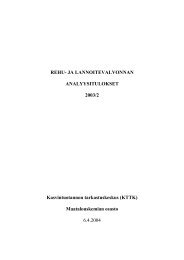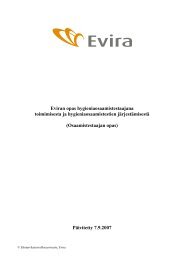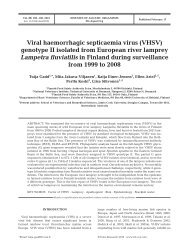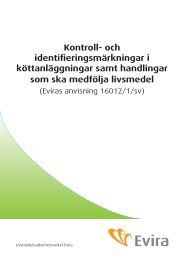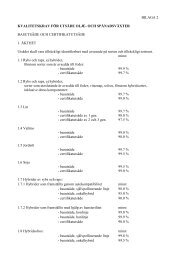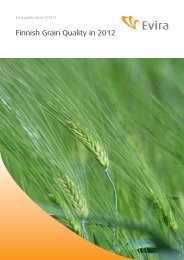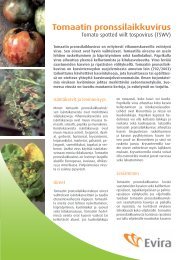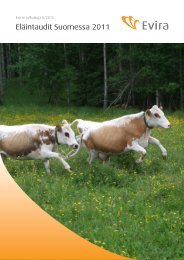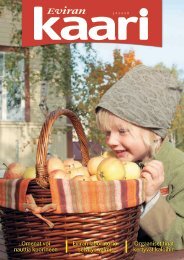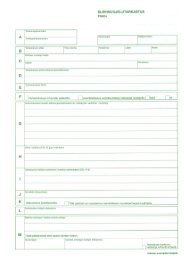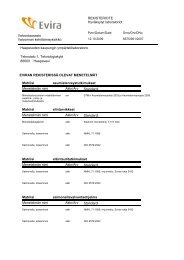Molecular characterization of endemic salmonella infections ... - Evira
Molecular characterization of endemic salmonella infections ... - Evira
Molecular characterization of endemic salmonella infections ... - Evira
You also want an ePaper? Increase the reach of your titles
YUMPU automatically turns print PDFs into web optimized ePapers that Google loves.
4. MATERIAL AND METHODS<br />
4.1 MATERIAL<br />
The Salmonella isolates were mainly obtained from the collections belonging to the Finnish Food<br />
Safety Authority <strong>Evira</strong> (the former National Veterinary and Food Research Institute, EELA, is a part<br />
<strong>of</strong> <strong>Evira</strong>), Helsinki, Finland, and to the National Public Health Institute, Laboratory <strong>of</strong> Enteric<br />
Pathogens, Helsinki, Finland. Phage typing <strong>of</strong> S. Typhimurium isolates was carried out at the<br />
National Public Health Institute in Finland, where it began by the Colindale method in March 1968.<br />
Escherichia coli strains V517 (35.6, 4.8, 3.7, 3.4, 1.8, 1.4 MDa) (Macrina et al 1978) and 39R861<br />
(98.0, 42.0, 23.9, 4.6 MDa) (Threlfall et al 1986b) were used as plasmid reference strains.<br />
4.1.1 S. Infantis isolates (I, II)<br />
The isolates (total no = 659) were obtained from the Finnish Food Safety Authority <strong>Evira</strong> in<br />
Helsinki, Finland. This includes the former National Veterinary and Food Research Institute (EELA)<br />
in Helsinki, and its regional laboratories in Oulu, Seinäjoki and Kuopio (n=655; 636 isolates from<br />
cattle from 478 farms, and 19 isolates from feed). The Plant Production Inspection Centre in<br />
Vantaa (n=4) is also now part <strong>of</strong> <strong>Evira</strong>.<br />
In the former province <strong>of</strong> Vaasa (where most S. Infantis isolations from cattle were made in the<br />
1990s) as early as 1971 the first isolations were found in: imported soya feed, hygiene samples in<br />
local slaughterhouses, pig, cattle, and a broiler rearing facility. In the subsequent years, isolations<br />
were obtained from poultry slaughterhouses and in 1976 from imported slaughterhouse waste.<br />
From 1978 onwards, cattle isolations have been obtained every year (Aho et al 1996; National<br />
Veterinary and Food Research Institute 1965-2005) (II: table 1).<br />
The analysed S. Infantis isolates from cattle originated from farms (n=588; 382 faecal and 206<br />
other isolates), slaughterhouses (n=15) and slaughter transportation vehicles (n=33) from 1985 to<br />
2003. Apart from carcass-samples from the slaughterhouse, the farm isolates were mostly found in<br />
faecal samples. The samples from slaughterhouses and cattle transportation vehicles were<br />
hygiene samples and therefore not to be traced to any specific farm. The cattle feed isolates<br />
originated from the feed production plant (n = 5) and cattle farms (n = 18). The cattle farm isolates<br />
were representative <strong>of</strong> the geographical distribution <strong>of</strong> S. Infantis positive farms (II: figure 2). Two<br />
or more isolates taken from 142 farms during the eradication <strong>of</strong> the infection were available for<br />
analysis. If available, isolates from faecal samples were analysed. The isolates were either<br />
obtained over the same year or from several years. All isolates had been serologically confirmed to<br />
be S. Infantis and stored at -70°C, except for the isolates obtained during the 1980s, which were<br />
stored on egg agar slopes prior to analysis.<br />
43



